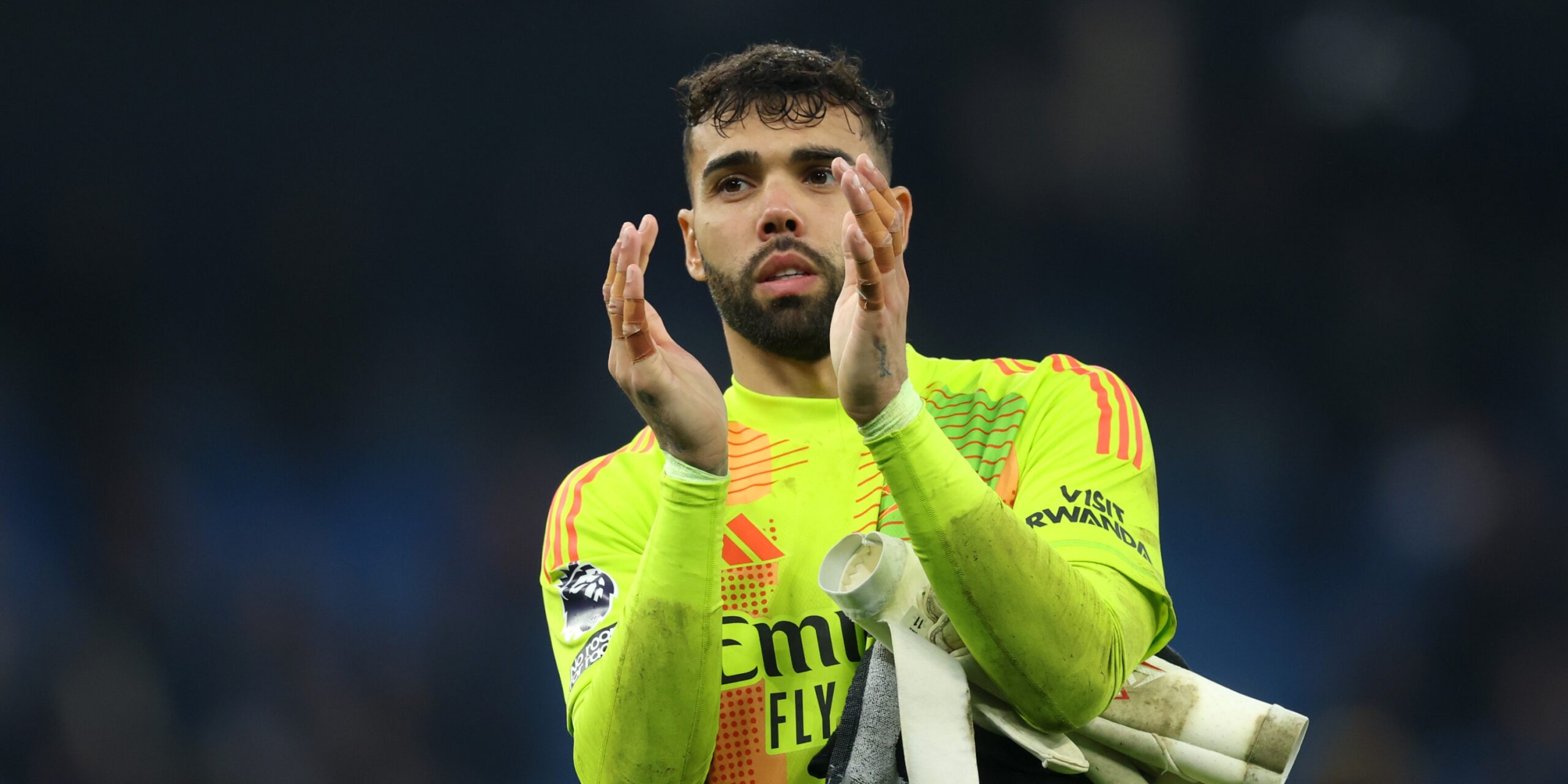David Raya has caught the eye for Arsenal during the early weeks of the season, giving reason to think he could make the difference in the Premier League title battle.
It seems unthinkable now, but when David Raya moved to Arsenal from Brentford, there was a genuinely legitimate discourse around whether they needed him and if he was even of the same calibre as Aaron Ramsdale.
Raya’s August 2023 arrival took some by surprise because Ramsdale had been pretty solid in the eyes of most during his first two seasons at the Emirates Stadium.
Mikel Arteta explained the Spaniard’s signing as him wanting to have “two excellent goalkeepers now who fit our style”.
Publicly at least, the suggestion was Arsenal were going to rotate their goalkeepers frequently throughout the season. It was a situation that brought plenty of criticism, with Gunners legends such as Arsène Wenger and David Seaman among those questioning the validity of the plan.
“I cannot have two players in each position and not play them,” Arteta snapped back after seemingly dropping Ramsdale without any great cause in mid-September 2023 for the trip to Everton.
Some might’ve been tempted to remind Arteta of that comment throughout the season then as Raya went on to make 41 appearances to Ramsdale’s 11, but any discussion tended to revolve around the latter being too good to be back-up rather than any reason why Raya ought to be dropped.
The fact is, Arteta clearly preferred Raya. For the most part, he fitted in seamlessly at Arsenal and some might argue he cut a more assured figure – especially if you bear in mind Ramsdale’s astonishing admission last year on the Behind the Game podcast that “if you ask me to concentrate on a match for 90 minutes, I’m finished; I can’t do it”.
After Arsenal’s FA Cup elimination by Liverpool on 7 January 2024, Ramsdale made just one more appearance that season, and his subsequent departure to Southampton after unsurprisingly beginning 2024-25 on the bench wasn’t a shock to anyone.
Raya vs Ramsdale became a discussion topic that very much fell by the wayside, however, and fittingly Raya’s enjoyed an exceptional start to the new season.
Of course, it’s impossible to begin anywhere other than Sunday’s 2-2 draw away to Manchester City. With Arsenal playing more than half the match with a numerical disadvantage following Leandro Trossard’s red card, Arteta’s men set up in the second half to defend a 2-1 lead with their lives.
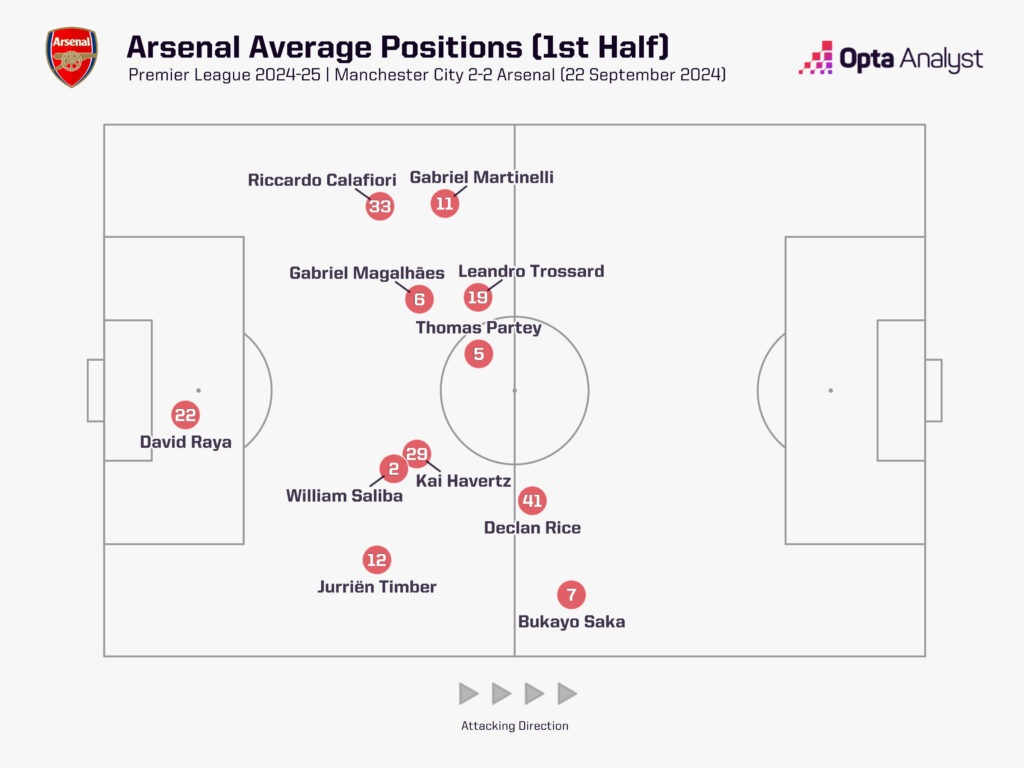
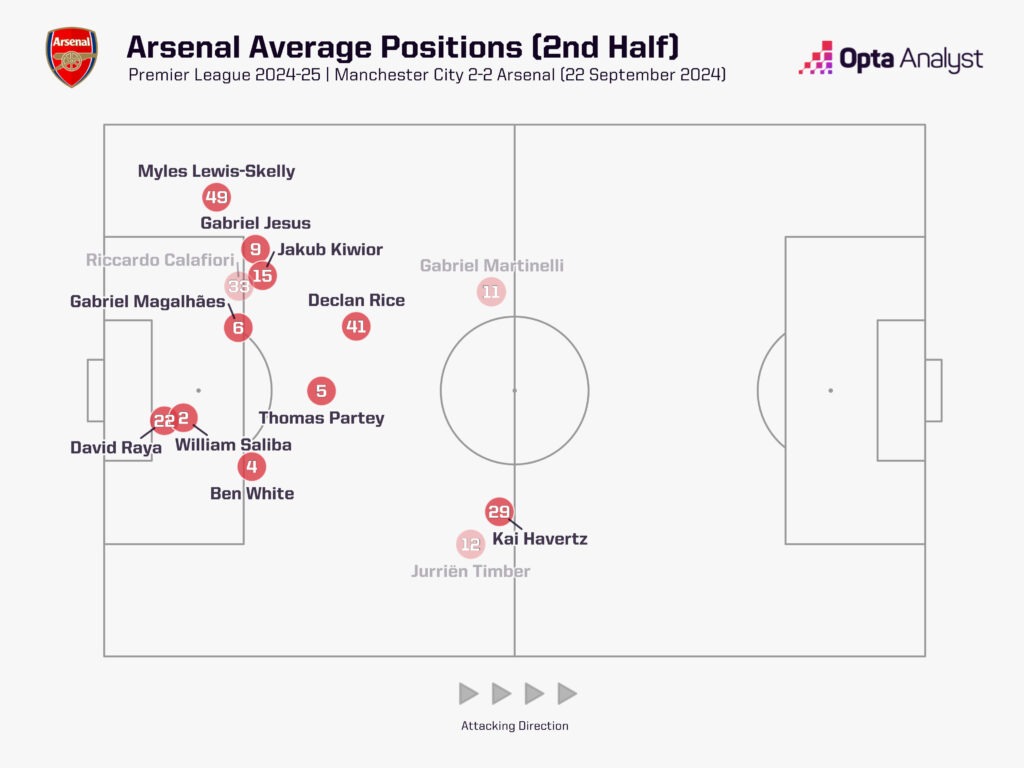
Arteta hasn’t shied away from the so-called uglier side of the game during his time in charge, and at the Etihad Stadium on Sunday, he set his team out to frustrate and physically overpower City, and then, following Trossard’s dismissal, to desperately defend a one-goal lead effectively with all 10 players behind the ball.
It nearly worked, and Raya was a big part of that, not just because he was happy to chew up the clock.
Granted, City were nothing close to their incisive best, often looking clueless as they tried to pass their way through the Arsenal defensive wall in front of them, and so clear-cut chances were difficult to come by – after all, City’s average of 0.05 expected goals (xG) per shot in the second half is their second-worst figure in the second period of a Premier League match under Pep Guardiola (min. 10 shots).
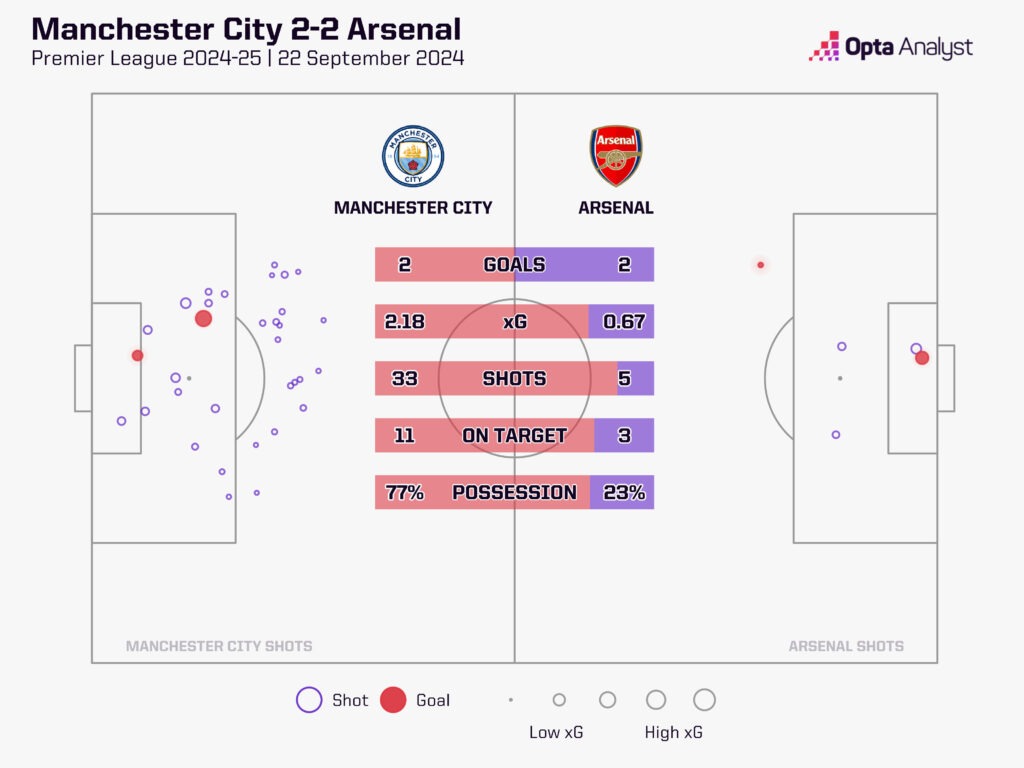
Nevertheless, Raya was busy. City’s 28 shots after the break was comfortably the most they’ve managed in a half of a league game under Guardiola (ahead of the 20 they had in the second half vs West Brom in December 2020), and they managed to get nine on target.
Raya’s nine saves over the course of the match was the joint most of all Premier League goalkeepers in a single match this season, while he’s only ever made more once (11 vs Brighton in April 2023).
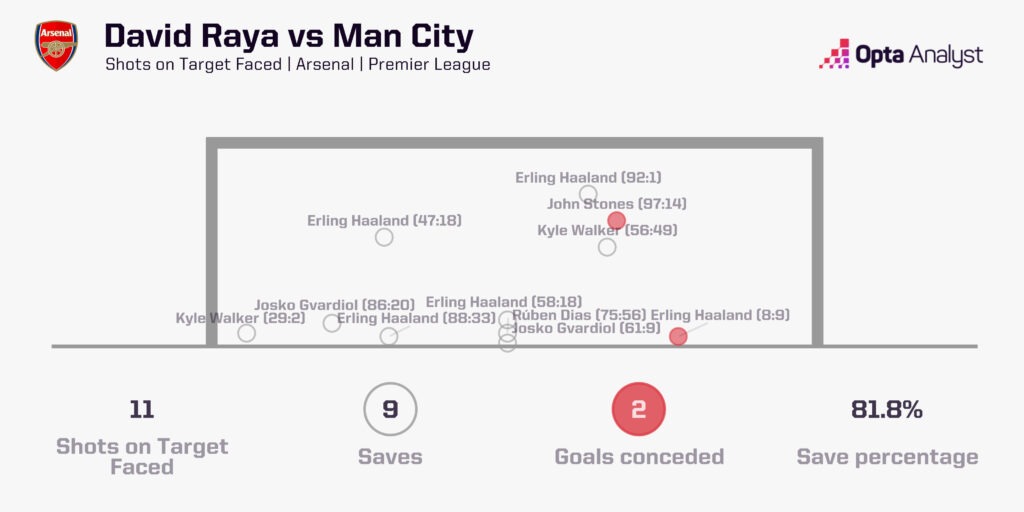
And while City’s xG total was fairly low in relation to the amount of shots taken, it shouldn’t be assumed that Raya’s saves were straightforward; his acrobatic stop down to his right to keep out Josko Gvardiol’s 87th-minute volley was outstanding, as was his earlier dive down the other way to scoop away an Erling Haaland header.
But it wasn’t just his saves. He operated with authority on the occasions he came out to meet crosses, with one particular claim from a corner deep into second-half stoppage time evoking such decisiveness that he had almost half his team bundling on him in congratulatory fashion; of course, Arsenal didn’t hold on, but he’d done his bit.
This performance was a microcosm of his season, however. Raya’s start to 2024-25 has been exceptional, there’s no other way to describe it, with several eye-catching saves standing out to help make that argument.
There was the recovery to deny Ollie Watkins’ diving header after Raya’s desperate attempt to save a deflected shot – that hit the crossbar – fell kindly to the Aston Villa striker; he kept out a goal-bound Yasin Ayari effort against Brighton (albeit, it was a questionable finish that gave the goalkeeper a chance); and who could forget the Mateo Retegui penalty and rebound follow-up double save in the Champions League last week?
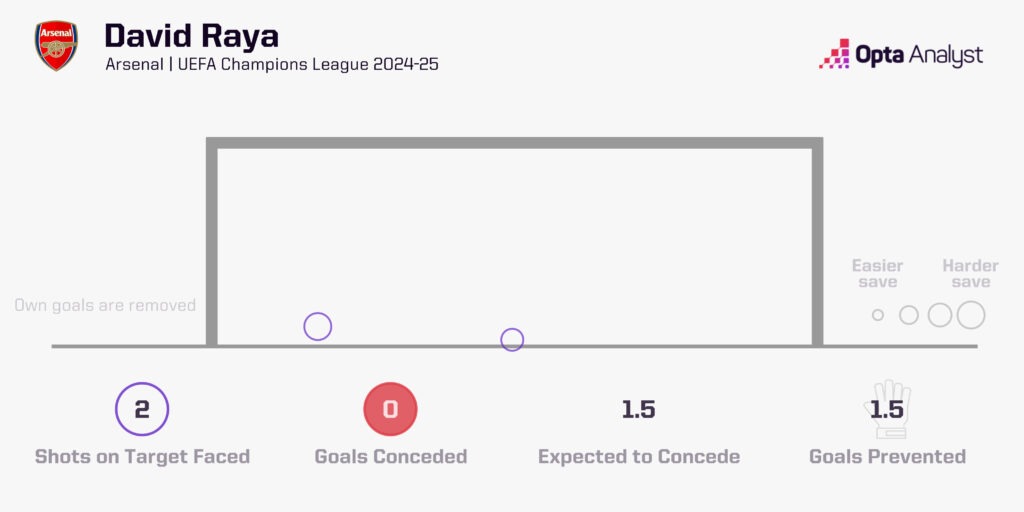
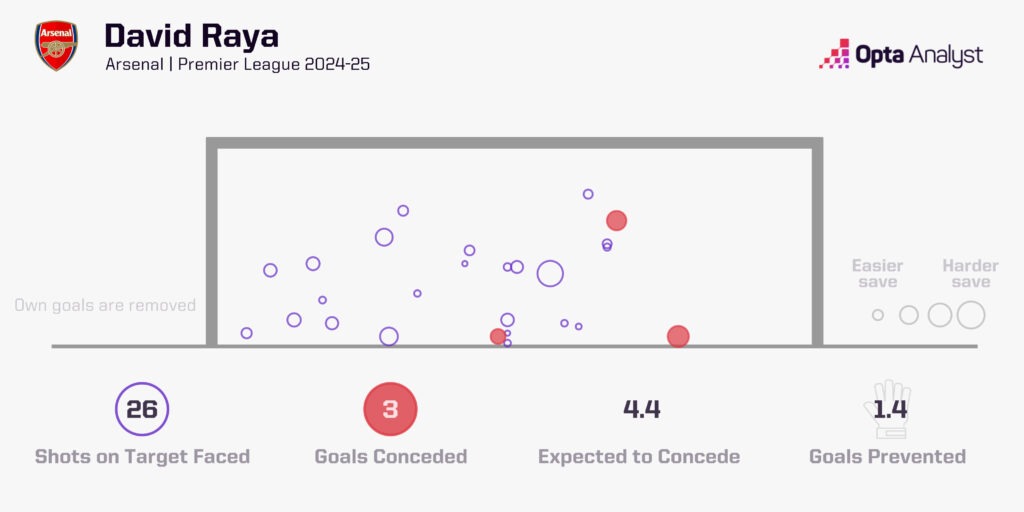
The numbers back up the eye test when it comes to Raya as well. While his 1.4 goals prevented according to the expected goals on target (xGOT) model has him at a perfectly respectable 11th among Premier League goalkeepers this season, it is a metric that tends to favour those who face lots of shots.
We can guard against this problem somewhat by using something called ‘goals prevented rate’. This is calculated by taking xGOT (how many goals the average goalkeeper ‘should’ concede) and dividing that figure by goals conceded (how many the goalkeeper actually conceded). Goals prevented rate then tells us the number of goals the average goalkeeper would concede for every goal the goalkeeper in question actually concedes.
Raya’s goals prevented rate of 1.45 is the seventh best in the Premier League this season (minimum two matches played) and suggests that for every goal he concedes, the average goalkeeper would concede 1.45 goals. This might not sound like much in isolation, but if you extrapolate it over a longer period of time, it can make a big difference. At that rate, for every 10 goals Raya was to let in, another average goalkeeper would concede roughly 14 or 15.
Furthermore, only Alisson (90%) has a better save percentage than Raya (88.5%) among goalkeepers to play at least two games, though the Brazilian’s total of nine saves is fewer than half the Arsenal stopper’s 23.
We also have to remember that one of the reasons Raya was brought in was for his distribution. It’s fair to say he had some moments last season when his passing was questionable, and his five errors leading to shots was the joint worst in the Premier League among goalkeepers.
This season, Raya’s passing accuracy in his own half is up to 97.1% from 91.5% in 2023-24, which is potentially partially explained by only 19.1% of his passes being made when under pressure by someone within five metres, compared to 26.2% last term.
Of course, the season’s still young and so we’re working with very small sample sizes across the board, but the point remains; Raya’s early form in 2024-25 is excellent, there’s no doubt about that.
The questions about whether he’s an upgrade on Ramsdale or not are now an irrelevance. Instead, as we consider how fine the margins are in Premier League title races, it’s entirely reasonable to wonder if Raya can ultimately be a decisive factor in Arsenal finally overcoming City in the long run and winning a first top-flight crown in 21 years – though that is assuming the injury he sustained isn’t serious after he was seen limping through the mixed zone after Sunday’s game.
When you take into consideration his goals prevented rate during these early weeks of the campaign, that’s genuinely a record that can make a difference when teams are potentially winning titles by a couple of points.
Arsenal need their goalkeeper to maintain this level; if he does and remains fit, Raya could conceivably be the difference between winning the title and falling agonisingly short once again.
Enjoy this? Subscribe to our football newsletter to receive exclusive weekly content. You should also follow our social accounts over on X, Instagram, TikTok and Facebook.
